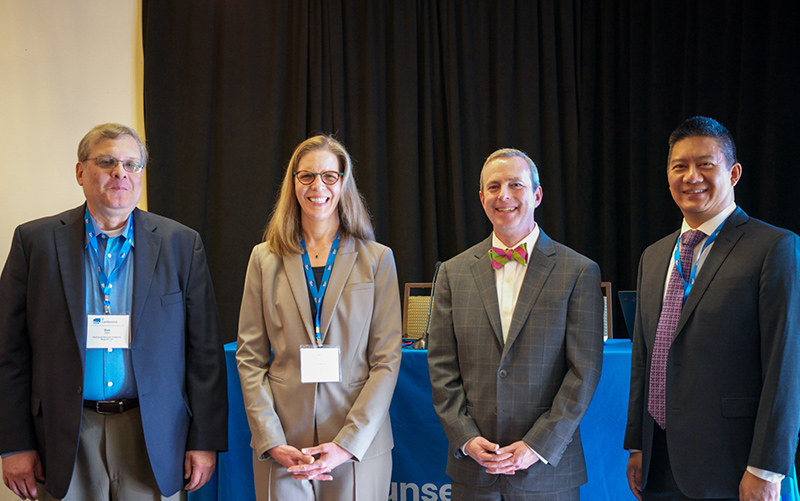September is Sepsis Awareness Month, and the Biotechnology Innovation Organization (BIO) is partnering with Sepsis Alliance to spread the word about sepsis and provide resources for patients and their families.
“Sepsis is the body’s life-threatening response to infection that affects 1.7 million people and takes 350,000 adult lives in the U.S. every year,” explains Sepsis Alliance. While sepsis can be caused by bacterial, viral, parasitic, or fungal infections, often originating in the lungs, skin, urinary tract, or gastrointestinal tract, many high-risk patients are unaware of the danger.
“Sepsis Awareness Month is an annual reminder to the world that we can all help save lives and limbs by raising sepsis awareness in our communities,” said President and CEO of Sepsis Alliance, Thomas Heymann. “Sepsis Alliance established the observance as a way to empower individuals, organizations, and communities to look out for one another through sepsis education.”
Here are the top 3 things you need to know about sepsis and how you can keep yourself and your family safe.
1. Sepsis is the leading cause of death in U.S. hospitals.
With at least 350,000 adult deaths per year in the U.S., sepsis is the silent killer of hospital systems and the #1 cost of hospitalization at $53 billion annually. Sepsis kills more patients than prostate cancer, breast cancer, and opioid overdose combined. Those who survive sepsis have a shortened life expectancy, are more likely to suffer from an impaired quality of life, and often experience worsened mental and physical function.
As Sepsis Alliance explains, “Infection Prevention is Sepsis Prevention™,” meaning “the risk of sepsis can be reduced by preventing or quickly identifying and managing infections.” This also includes preventative medical practices, such as practicing good hygiene, staying current with vaccinations, and seeking treatment when infections are suspected.
2. Sepsis is an equal-opportunity killer, but…
Sepsis can affect anyone, regardless of whether or not a patient is ill or well, young or old. However, some groups are more likely to be affected. Very young children, older adults, those with a weakened immune system, racial and ethnic minorities, and lower-income individuals and families face an increased risk.
Centers for Disease Control and Prevention (CDC) found that sepsis-related death rates increased with age among adults aged 65 and over, with deaths increasing from 150.7 per 100,000 for those aged 65–74, to 331.8 for those aged 75–84, to 750.0 among those aged 85 and over. That is an increase of about three to seven times as patients age.
Additionally, older males face more at risk of sepsis than women. According to the CDC, among adults aged 65–74, the rate of sepsis was 172.6 per 100,000 for men compared with 131.5 per 100,000 for women. Gender disparities also increase with age as men aged 75–84 see a rate of sepsis at 387.1 per 100,000, compared with women who see 288.7 per 100,000, and adults aged 85 and over see a rate of 892.4 per 100,000 for men compared with 669.9 per 100,00 for women.
Sepsis-related deaths also increase for rural patients compared to urban. “Death rates were higher in rural areas than urban areas for age groups 65–74 (175.6 [per 100,000] compared with 145.7), 75–84 (365.6 compared with 324.7), and 85 and over (801.2 compared with 739.9),” the CDC found.
Some of this is a result of poorer access to healthcare facilities in rural communities. However, “adults with lower levels of education, income, and/or material resources, are at greater risk of sepsis mortality,” explains Sepsis Alliance.
Patients of color also see higher rates of sepsis and death, and much of that stems from inequitable care. As Sepsis Alliance notes, “Black patients admitted to the emergency room are assigned to significantly lower priority status and experience significantly longer wait times (10.9 minutes longer on average) as compared to case-matched white patients.” These disparities are found in pediatric care, as well: “Non-Hispanic Black children admitted to the emergency room are less likely to be treated for sepsis than non-Hispanic white children.”
3. When it comes to sepsis, remember It’s All About TIME™!
One of the most dangerous things that can happen is that sepsis is not properly diagnosed—or worse, ignored. So, it is important to know the signs.
It’s all about TIME:
- T – Temperature: Is a patient’s temperature higher or lower than normal?
- I – Infection: Patients may have signs or symptoms of infection, if so they could be at serious risk of sepsis.
- M – Mental Decline: Is the patient confused, sleepy, or difficult to rouse?
- E – Extremely Ill: Is the patient experiencing severe pain, discomfort, or shortness of breath? If experiencing a combination of these symptoms, call for help immediately.
When it comes to helping a loved one, voice your concerns about sepsis. It is incredibly important to advocate for yourself or a loved one if you are concerned about sepsis, with Sepsis Alliance recommending patients be clear and say, “I AM CONCERNED ABOUT SEPSIS” when calling for an ambulance or talking to a doctor.
Want to learn more? Attend the Sepsis Alliance Summit
There are more resources than ever when it comes to learning about sepsis and advocating for yourself. To add to these resources, Sepsis Alliance is holding a free online Sepsis Alliance Summit from September 25–27, and anyone can join.
“Providing free, high-quality education on the intricacies of sepsis diagnosis, treatment, and care through Sepsis Alliance Summit and our other Sepsis Alliance Institute offerings is necessary in the fight to save lives from sepsis,” said Heymann. “We encourage healthcare professionals from all backgrounds and specialties to attend since sepsis can be found anytime and in any care setting.”
Participants can focus on a range of areas around sepsis education including prevention, recognition, statistics, and post-diagnostic care. Participants can join live webinars, as well as sign up for continued learning.
“Mortality increases 4-9% for every hour that treatment is delayed,” writes Sepsis Alliance. “YOU can help save lives and limbs by staying up-to-date on current recommendations and guidelines around sepsis by joining us at the 5th Annual Sepsis Alliance Summit.”
Passing the PASTEUR Act
One way to fight sepsis on a political level is through a piece of must-pass legislation called the Pioneering Antimicrobial Subscriptions To End Upsurging Resistance Act, or the PASTEUR Act.
“This bill authorizes the Department of Health and Human Services (HHS) to enter into subscription contracts for critical-need antimicrobial drugs,” as explained on the bill’s webpage.
“As we explored during our recent Sepsis Alliance AMR Conference (2023), the AMR crisis is closely linked to sepsis,” writes Sepsis Alliance. “Because sepsis often requires effective antimicrobial medications to treat, AMR makes infections more likely to develop into sepsis.”
“Not only is antimicrobial resistance one of the biggest threats to public health broadly, it’s also a significant—and growing— cause of sepsis worldwide,” said Heymann. “The PASTEUR Act is a vital step toward curbing these connected public health crises. This bill helps ensure that we can continue to effectively treat infections – and keep them from progressing out of control into life-threatening sepsis.”
Both BIO and Sepsis Alliance strongly support the passage of the PASTEUR Act and as the election season moves into high gear and the lame duck legislative period approaches, the time is now to pass this critical policy.
For additional information, visit sepsis.org and check out Sepsis Alliance’s fact sheets.




